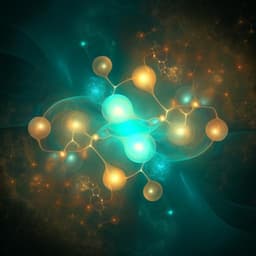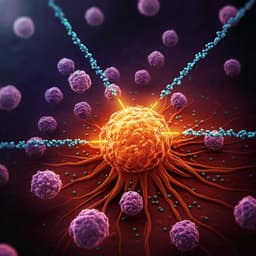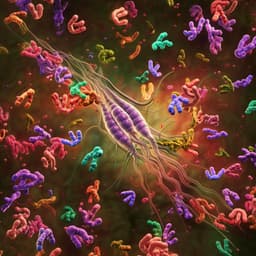
Medicine and Health
Coacervation in polyzwitterion-polyelectrolyte systems and their potential applications for gastrointestinal drug delivery platforms
K. O. Margossian, M. U. Brown, et al.
This research introduces poly-zwitterionic complexes (pZCs) that can revolutionize drug delivery by exhibiting unique pH-responsive behavior, making them ideal for enhanced oral drug uptake. Conducted by Khatcher O. Margossian, Marcel U. Brown, Todd Emrick, and Murugappan Muthukumar, this study explores their potential in gastrointestinal conditions.
~3 min • Beginner • English
Introduction
The study addresses whether polyzwitterion–polyelectrolyte mixtures can undergo complex coacervation with phase behavior inverted relative to traditional polyelectrolyte complexes, enabling stability in strong acid and disassembly at higher pH. Classical coacervates form when oppositely charged polyelectrolytes associate, driven by counterion release and electrostatics, typically within an intermediate pH window that maximizes charge on both chains. Shifting stability to lower pH could enable gastrointestinal (GI) applications, exploiting the large pH gradient between the stomach (acidic) and the duodenum (near neutral to basic). The authors propose and examine complexes between a polyzwitterion, PMPC, and a weak polyacid, PAA. They hypothesize that at low pH PMPC bears a net positive charge (protonated phosphoryl group) interacting strongly with dipolar PAA units via dipole–charge interactions with counterion release, while at higher pH both chains are effectively dipolar and only weak dipole–dipole interactions remain, precluding complexation. The goal is to demonstrate such orthogonal pH-dependent phase behavior and assess potential for pH-triggered GI drug delivery.
Literature Review
Complex coacervates of oppositely charged polyelectrolytes have been extensively studied since the early 20th century, with well-established driving forces including electrostatics and counterion release. Prior work spans diverse chemistries (biomimetic monomers, block copolymers, chiral/sequenced architectures) yet generally relies on uniformly charged macromolecules and shows stability at intermediate pH where both species are ionized. Traditional systems disassemble at very low or very high pH due to insufficient ionization. In contrast, exploiting zwitterionic monomers with pH-tunable net charge can shift the stability window to acidic ranges, relevant to physiological gradients in the GI tract. The work builds on theoretical perspectives of polyelectrolyte complexation, including the roles of charge–charge, dipole–charge, and dipole–dipole interactions and counterion release, to propose an alternative coacervation mechanism in polyzwitterion-containing systems.
Methodology
Materials: PMPC (Mn ≈ 22,000 g/mol) was synthesized via RAFT polymerization of 2-methacryloyloxyethyl phosphorylcholine (MPC) using 4-cyano-4-(phenylcarbonothioylthio)pentanoic acid (CTA) and ACVA initiator. Reaction in water/methanol was degassed with N2, run at 70 °C for 6 h, quenched, dialyzed against water, and freeze-dried (86% yield). GPC (TFE/NaTFA eluent) and 1H NMR (D2O) characterized the product. PAA (Mn ≈ 50,000 g/mol) was purchased as 25 wt% and diluted to 1 wt%.
Sample preparation: PMPC and PAA stock solutions (1 wt%) were adjusted to pH 2–12 (1-unit increments) using HCl/NaOH. Mixtures were prepared at total polymer concentration 0.75 wt% with stoichiometric ratios varied in 10% increments (PMPC added before PAA), vortexed for 10 s between steps.
Turbidimetry: Optical density at 550 nm was measured (Tecan Infinite 200 Pro) in 96-well plates, with temperature varied from 20 °C to 40 °C in 5 °C increments. OD defined as T = log10(I0/I). Samples were shaken before measurement.
Optical microscopy: Polarized light microscopy (Leica DM 2700P, 10× objective) captured images of droplet morphology. Video microscopy used Phantom PCC software to record time-resolved responses.
Physical simulation of pH-triggered dissociation: A 300 µL droplet of PMPC-PAA mixture was placed on a glass slide. A 15 µL water droplet was used to wet a line at the edge of the polymer droplet. Then 15 µL concentrated NaOH was deposited at the wet line apex to create a unidirectional pH front moving through the droplet, visualized by video microscopy.
Energetics modeling: Local pair interactions between PAA repeat units and PMPC monomers were modeled. Nearest approach distances were estimated using Avogadro with MMFF94 minimization, giving 0.38 nm (dipole–charge; PAA dipole with PMPC cation) and 0.59 nm (dipole–dipole; PAA dipole with PMPC zwitterion). Interaction energies as functions of separation were computed for dipole–charge (vac) and dipole–dipole (vdd) using Bjerrum length l ≈ 0.75 nm (water, room temperature), inverse Debye length κ ≈ 0.329 nm−1 at pH 2 and 0.0329 nm−1 at pH 4, PAA dipole moment p1 ≈ 0.0354 e·nm (1.7 D), and zwitterion dipole p2 ≈ 0.39 e·nm (18.74 D). Cutoffs were the nearest distances above.
Composition analysis of dense phase: Representative mixtures (e.g., 30:70 PMPC:PAA at pH 2) were centrifuged to isolate polymer-rich phase, supernatant removed, and the dense phase lyophilized. NMR confirmed presence of both PMPC and PAA in the dense phase.
Titrations: 0.75 wt% polymer solutions (400 µL) were titrated with acid/base in 1 µL steps while stirring; pH recorded after 1 min equilibration.
Cargo encapsulation and release: Fluorescently labeled BSA (Alexa Fluor) was added between PMPC and PAA additions to enable encapsulation during droplet formation. Phase separation by centrifugation allowed measurement of protein distribution via absorbance at 495 nm (protein) and 550 nm (turbidity). Confocal fluorescence microscopy confirmed co-localization of protein in droplets. pH-dependent release was assessed by increasing pH (2 to 5) and monitoring supernatant protein concentration.
Key Findings
- PMPC-PAA mixtures undergo liquid–liquid phase separation into spherical droplets (pZCs) at low pH. Turbidity vs stoichiometry shows at pH 2 a pronounced peak at 30:70 PMPC:PAA with a secondary peak near 80:20; at pH 3 the peak shifts to 60:40 and is an order of magnitude lower than at pH 2, with broader stoichiometric tolerance.
- Optical microscopy reveals abundant, mobile, coalescing spherical droplets at pH 2 and fewer droplets at pH 3; no detectable complexation at pH ≥ 4 across stoichiometries.
- Preliminary droplet size estimates (ImageJ) show broad distributions centered around ~2.1 µm at pH 2 and ~1.65 µm at pH 3.
- Phase diagram maps complexation as a function of stoichiometry and pH, corroborating turbidimetry and microscopy; complexation largely confined to pH ≤ 3 and appropriate mixing ratios.
- Control tests show no self-complexation of PMPC or PAA alone upon pH changes; NMR of the dense phase confirms both PMPC and PAA are present, ruling out self-assembly of a single component.
- Mechanism: At low pH, PMPC monomers carry net +1 (protonated phosphoryl), enabling strong dipole–charge attraction to dipolar PAA, augmented by counterion release. At higher pH, PMPC is zwitterionic (net 0), leaving only weak dipole–dipole interactions, insufficient for complexation.
- Henderson–Hasselbalch analysis of PMPC phosphorylation state: fraction of positively charged PMPC monomers ≈ 80% at pH 2, 28% at pH 2.5, and 3.8% at pH 3. Combining with peak stoichiometries yields ~24% charged PMPC units in the mixture at pH 2 (0.30 × 0.80) vs ~2.3% at pH 3 (0.60 × 0.038), matching the observed order-of-magnitude OD difference.
- Energetic estimates: nearest approach distances ~0.38 nm (dipole–charge) and ~0.59 nm (dipole–dipole). Computed pair interaction energies show dipole–charge attraction about an order of magnitude stronger than dipole–dipole under conditions used, consistent with complexation only at low pH.
- Temperature stability: For peak-stoichiometry samples, turbidity is largely unchanged from 20–40 °C at both pH 2 (30:70) and pH 3 (60:40), indicating robustness to physiological temperature variations.
- Non-equilibrium pH response: A controlled NaOH front traversing a droplet dissolves pZC droplets progressively; the effect is due to pH increase, not dilution (water control shows no dissolution). Dissociation is reversible: re-acidification with HCl reforms droplets.
- Cargo encapsulation: Fluorescent BSA co-localizes within pZC droplets at low pH; negligible protein is detected in the polymer-poor supernatant under acidic conditions. As pH rises from 2 to 5, protein concentration in the supernatant increases, evidencing pH-triggered release.
- The observed orthogonal phase behavior (acid-stable, base-labile) aligns with GI conditions: stability in the stomach (pH ~2) and disassembly in the duodenum (pH 6–8).
Discussion
The findings demonstrate that incorporating a polyzwitterion (PMPC) with a polyanion (PAA) yields coacervate-like droplets whose stability window is shifted to low pH, in contrast to canonical polyelectrolyte complexes. This behavior arises because PMPC’s net charge is pH-tunable: at low pH, strong dipole–charge interactions with PAA, plus counterion release, drive complexation; at higher pH, PMPC becomes neutral zwitterionic and only weak dipole–dipole interactions remain, preventing assembly. Quantitative trends in turbidity, stoichiometric shifts, and microscopy are consistent with the fraction of protonated PMPC monomers and energetic estimates. The system satisfies key GI delivery criteria—stability in gastric acid, disassembly near neutral pH, and temperature robustness—supporting its potential as a pH-triggered carrier for oral delivery. The reversible, responsive dissolution under a moving basic front, and successful encapsulation/release of a model protein, further underscore applicability. The work suggests that tuning zwitterion chemistry (pKa, permanent charge identity/placement) can program desired phase windows and potentially invert behavior (base-stable, acid-labile) when paired with complementary partners, with implications for both synthetic systems and interactions with zwitterionic biomacromolecules (e.g., proteins).
Conclusion
This study introduces polyzwitterionic complexes (pZCs) formed by PMPC and PAA that exhibit orthogonal pH-dependent phase behavior: stable coacervate droplets at low pH and disassembly at higher pH. Experiments (turbidimetry, microscopy, phase mapping) and qualitative energetics support a mechanism based on pH-controlled transition from dipole–charge to dipole–dipole interactions and counterion release. The complexes are robust from 20–40 °C, dissolve near pH 4 and above, show reversible pH responsiveness, and can encapsulate and release protein cargo, highlighting utility for GI drug delivery. Future directions include: tailoring zwitterion monomer chemistry to shift stability ranges or achieve inverse behavior; expanding to other polyzwitterions/polycations; detailed characterization of droplet internal structure and dynamics; quantifying effects of ionic strength and physiological cofactors; and developing formulation strategies for specific therapeutics in complex GI environments.
Limitations
- Detailed quantitative energetics are limited by unknown local dielectric environments, water structuring, and molecular-level complexities; calculations provided are qualitative.
- High turbidity hindered scattering-based structural characterization; robust droplet size distributions and internal structure (Rg, Rh) were not comprehensively measured.
- The study focuses on one polymer pair (PMPC-PAA); generality across chemistries, molecular weights, and architectures remains to be systematically validated.
- Physiological variables beyond pH and temperature (e.g., ionic strength, enzymes, bile salts, mechanical shear, food matrix) were not fully explored.
- Kinetics of droplet formation/coalescence and long-term stability were not resolved; some measurements reflect snapshots rather than steady-state distributions.
Related Publications
Explore these studies to deepen your understanding of the subject.







